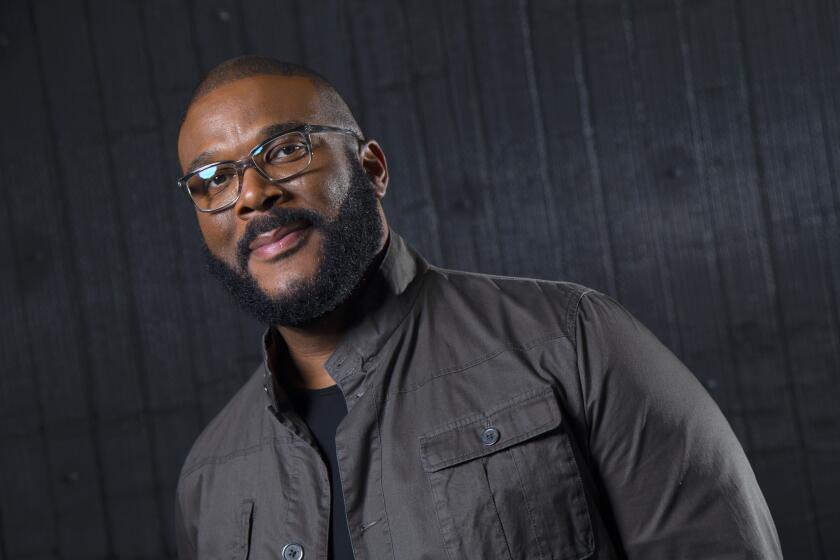How ‘Toy Story’ changed the face of animation, taking off ‘like an explosion’
- Share via
Making “Toy Story,” the first entirely computer-generated animated feature, reminded John Lasseter of those old Mickey Rooney-Judy Garland musicals in which a character inevitably proclaims, “My dad’s got a barn. Let’s put on a show.”
“There was an innocence about us, with this absolute belief we could do it,” said Lasseter, who co-wrote and directed the 1995 comedy that earned Oscar nominations for original song, musical or comedy score, and screenplay, a first for an animated film. Lasseter received a special achievement award for his leadership of the animation team.
On Thursday evening, the Academy of Motion Picture Arts and Sciences is celebrating the 20th anniversary of the Pixar classic about a young boy’s toys, led by Woody (Tom Hanks) and Buzz Lightyear (Tim Allen), that come to life when the boy is not around.
SIGN UP for the free Indie Focus movies newsletter >>
Lasseter, chief creative officer for Walt Disney and Pixar Animation Studios, and Ed Catmull, the studios’ president, will talk about the making of the blockbuster with actor-director Jon Favreau as host at the Samuel Goldwyn Theater.
“Toy Story,” said Randy Haberkamp, the academy’s managing director for programming, education and preservation, changed the face of animation, noting that there have been more than 250 computer-animated features released since 1995. “It was this huge thing that took off like an explosion.”
The film, Haberkamp said, also altered “the face of visual effects in live-action movies. But if they had done all that technology and the characters hadn’t been interesting or the story had been weak, we wouldn’t be talking about it.”
“There was a deep understanding right to begin with this was not about technology,” said Catmull, who was executive producer of “Toy Story,” created the digital-animation program that made the film possible and received an Oscar for his contributions to one of the software programs, RenderMan. Yet when the film was released, noted Catmull, “almost all of the reviews only mentioned in one sentence that it was done on computer. We took incredible pride in that. We had succeeded because we hadn’t made it about the technology. We made it about the story, which is what our goal had been.”
RenderMan, said Catmull, was just one element in bringing “Toy Story” to life. “We had to build an entire infrastructure,” he said.”
The story of every Pixar film, said Lasseter, including this year’s acclaimed hit “Inside Out” and the upcoming “The Good Dinosaur,” goes through several versions because “all of the stories we have created are original.”
In the case of “Toy Story,” said Lasseter, “ we knew what computer animation could do. What its strengths were. And we knew what it couldn’t do.”
So they looked at subject matters that played to the strengths of computer graphics at that time. When they began the film in 1991, “rendering systems were not as sophisticated as they are now,” said Lasseter, who is directing “Toy Story 4.”
“Everything tended to look like plastic or more plasticky. So why not have the main characters made of plastic? So having toys as characters really lent itself [to the software]. Humans were by far the most difficult to create, so we really told the story from the toys’ point of view. So most of the time you saw Andy, his mom and sister from their hands and feet. The shots were not necessarily about them.”
They also didn’t want to copycat what Disney animation was doing at the time with its Broadway-style musical animated films such as 1991’s “Beauty and the Beast” and 1992’s “Aladdin.”
“We kind of made a list of what we didn’t want our movie to be,” Lasseter said. “We didn’t want a break-out-in-song musical. “We didn’t want it to be a fairy tale. We had done a short film, [the Oscar-winning] ‘Tin Toy,’ and felt the idea of toys coming alive when people weren’t around had a lot of possibilities.”
But they were worried it might be too juvenile for older kids and adults. “We felt the key was the choosing of the toys,” said Lasseter. “We did a lot of research of the types of toys that were around when we were kids.”
They realized there had been no animated buddy pictures. The genre, Lasseter said, “satisfied our desire to have the main characters be the most interesting characters. We were interested in having flawed main characters. There is a tendency to have the villain or the secondary characters be the most interesting characters. They are afraid to make the leads flawed.”
They also decided to make the toys adults. “They are not children themselves, so when the toys come alive, we kind of made it more like a workplace,” Lasseter said. “We started populating the film with contrasting types of characters, and we found ourselves putting ourselves into all of these characters.
“It was so fun to develop this. We were up in the San Francisco area away from Hollywood. We were just kind of working. We showed the story to the Disney animation executives every few months to get their notes. But no one was paying attention to us.”
---------------------
‘Toy Story: 20 Years of Being an Animation Game-Changer’
Where: Samuel Goldwyn Theater, 8949 Wilshire Blvd., Beverly Hills
When: 7:30 p.m. Oct. 1
Tickets: $3 to $5
Info: www.oscars.org
MORE:
‘Finding Dory,’ ‘Moana,’ ‘Toy Story 4’ among projects discussed at Disney’s D23
‘Shaun the Sheep’: What a script with no dialogue looks like
‘The Good Dinosaur’ trailer: Pixar goes for the natural look
More to Read
Only good movies
Get the Indie Focus newsletter, Mark Olsen's weekly guide to the world of cinema.
You may occasionally receive promotional content from the Los Angeles Times.










